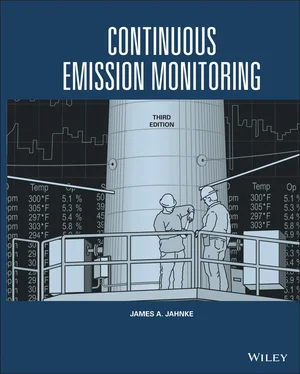James A. Jahnke - Continuous Emission Monitoring
Здесь есть возможность читать онлайн «James A. Jahnke - Continuous Emission Monitoring» — ознакомительный отрывок электронной книги совершенно бесплатно, а после прочтения отрывка купить полную версию. В некоторых случаях можно слушать аудио, скачать через торрент в формате fb2 и присутствует краткое содержание. Жанр: unrecognised, на английском языке. Описание произведения, (предисловие) а так же отзывы посетителей доступны на портале библиотеки ЛибКат.
- Название:Continuous Emission Monitoring
- Автор:
- Жанр:
- Год:неизвестен
- ISBN:нет данных
- Рейтинг книги:4 / 5. Голосов: 1
-
Избранное:Добавить в избранное
- Отзывы:
-
Ваша оценка:
- 80
- 1
- 2
- 3
- 4
- 5
Continuous Emission Monitoring: краткое содержание, описание и аннотация
Предлагаем к чтению аннотацию, описание, краткое содержание или предисловие (зависит от того, что написал сам автор книги «Continuous Emission Monitoring»). Если вы не нашли необходимую информацию о книге — напишите в комментариях, мы постараемся отыскать её.
The new edition of the only single-volume reference on both the regulatory and technical aspects of U.S. and international continuous emission monitoring (CEM) systems Continuous Emission Monitoring
Continuous Emission Monitoring:
Continuous Emission Monitoring, Third Edition
Continuous Emission Monitoring — читать онлайн ознакомительный отрывок
Ниже представлен текст книги, разбитый по страницам. Система сохранения места последней прочитанной страницы, позволяет с удобством читать онлайн бесплатно книгу «Continuous Emission Monitoring», без необходимости каждый раз заново искать на чём Вы остановились. Поставьте закладку, и сможете в любой момент перейти на страницу, на которой закончили чтение.
Интервал:
Закладка:
In the United States, the verification or certification procedures established for CEM systems are given in standards called “performance specifications.” The performance specifications include requirements for the installation, design, performance, and testing of CEM systems. The installation criteria are regulatory guidelines for identifying measurement locations where representative measurements can be expected. Design specifications require that the instruments must be designed in a certain manner. These are important and specified in detail for opacity monitors, but are minimal for gas monitors.
The specifications for the performance of the monitoring systems are the most important part of these standards (except for opacity monitors, where the design specifications predominate). Specifications are given for drift, relative accuracy, and, in some cases, linearity. Basically, the design of a gas monitoring system is not relevant to the specifications. It does not matter whether the system is extractive or in‐situ or if the method of measurement is electro‐optical or electrochemical. It does matter, however, how the system performs . The proof of a system is in its performance as installed. The performance specification test procedures are applied to demonstrate that the installed CEM system meets “performance specifications.” If a CEM system meets these specifications, it is considered capable of providing quality data for the purpose of the implementing rule.
Sixteen sets of performance specification have been established for pollutant and diluent gas flow and particulate monitoring systems for sources subject to the New Source Performance Standards. Sources are required to meet these specifications after an applicable monitoring system has been installed or when otherwise called out by a rule. The NSPS specifications are found in Appendix Bof 40 CFR 60. Other specifications are given for other implementing rules, and the states may write their own performance specifications (e.g. Pennsylvania and California). The Code of Federal Regulations citations where performance specifications for other implementing rules can be found are given in Table 2‐4.
As noted, EPA does not approve specific brands of instrumentation or specific analytical methods (in the case of gas monitoring) for source monitoring systems. This is in contrast to the policy of approving specific instrument models for continuous ambient air analysis. The procedure of meeting performance specifications provides latitude in continuous monitoring system design and application by allowing sources to handle individual monitoring problems. Since stack conditions vary from plant to plant, a CEM system found to work well at one plant may not work at another. Vibration, heat, or other conditions may necessitate a careful analysis of available monitors and systems before one can be chosen for the job. The performance specifications define the procedures to be used for checking the installed instrument's performance. It is the installed instrument system, operating on the stack, that is approved, not the model.
TABLE 2‐4 Performance Specifications for U.S. EPA Implementing Rules
| Originating EPA Office | Program | Citation for Implementing Rule Performance Specifications |
|---|---|---|
| OAQPS | NSPS | 40 CFR 60 Appendix B |
| OAQPS | Air toxics | 40 CFR 63.8 monitoring requirements |
| OAR‐ARD | Acid rain | 40 CFR 75 Appendix A |
| OSW | Boilers and industrial furnaces | 40 CFR 266 Appendix IX |
| OWM | Sewage sludge incinerators | 40 CFR 503 Subpart E |
U.S. CEM system certification procedures differ from those instituted in the European Union, where CEM system analyzers must undergo “type” testing, both in the laboratory and field, to show that they meet the design and performance specifications of the EU standard EN 15267. However, it has been found that a CEM system accredited under EN 15267 does not necessarily guarantee that it will pass a U.S. Performance Specification Test after installation.
QUALITY ASSURANCE REQUIREMENTS
The earliest applications of CEM systems in the 1970s were often met with frustration. Systems were installed and certified, but over a period of time began to fail. Either inconsistent data or no data would be generated. Often, the monitoring systems behaved so poorly that the data would not be accepted by control room operators. The problem was not so much in the instrumentation itself, but in misconceptions in how the systems operated. CEM systems were viewed as just another plant sensor, such as a thermocouple or pressure gauge – once installed, it would be expected to function for an extended period of time; failure could be corrected by a simple replacement. CEM systems, however, are more complicated than sensors. If not serviced periodically, serious corrosion and plugging problems can result, which can lead to a breakdown of the system. Failures cannot always be corrected through simple replacement, but instead may require expensive repairs and recertification.
The realization came quickly that in order to continue operating, a CEM system must be maintained continually (Jahnke 1986). Periodic inspections, a preventive maintenance program, and performance assessment procedures are all necessary for a CEM system to provide quality data on a continuing basis. These are the elements of a quality assurance program.
A quality assurance (QA) program requirement should be either part of an implementing rule or referred to in an appendix, as are the performance specifications in the NSPS requirements. QA requirements should include the preparation of a QA manual that describes the quality assurance and quality control procedures that will lead to optimum data quality for the CEM installation. Quality control procedures should detail the calibration methods, preventive maintenance activities, data back‐up procedures, and so on. Periodic audits such as systems audits and performance audits mandated by the regulatory agency should be part of the plan. Performance audits that use independent audit materials (e.g. calibration gases) or independent test instruments are recommended for providing quantitative assessments of data quality. Systems audits conducted by either internal or external auditors provide an assessment of whether the QA program has been implemented and is operating effectively.
Part 60 Quality Assurance Procedures
Quality assurance programs were not required for CEM systems in the implementing rules promulgated by EPA in the 1970s and early 1980s. After the initial certification was achieved by passing the performance specification tests, no further testing was required, unless requested by the agency for special circumstances. It was not until the 1980s that EPA proposed minimum quality assurance procedures for SO 2, NO x, and diluent monitoring systems in Appendix F to 40 CFR 60 (U.S. EPA 2020e). This rule was promulgated in 1987 and is today known as Procedure 1 of Appendix F. Other procedures were added to Appendix F as continuous monitoring requirements extended to the measurement of other pollutants, such as mercury and hydrochloric acid. However, quality assurance procedures for opacity monitors were not published until 2014 (U.S. EPA 2014a) although opacity monitors have been required at certain facilities since 1973.
Other U.S. QA Procedures
QA requirements for acid rain Part 75 CEM systems were promulgated along with the implementing rule and are found in 40 CFR 75 Appendix B(U.S. EPA 2020h). The requirements include procedures for SO 2and NO xmonitoring systems, O 2and CO 2diluent monitors, and flow monitors. The flow monitoring procedures are especially important because none are given in Part 60 Appendix F. It is obvious from Equation 2‐1that the flow measurement is as equally important in pollutant mass emission rate determinations as is the gas measurement. The flow monitoring performance audit procedures such as the “flow‐to‐load ratio test” and semiannual/annual relative accuracy test audits are valuable, if not necessary for assuring accurate flow measurements.
Читать дальшеИнтервал:
Закладка:
Похожие книги на «Continuous Emission Monitoring»
Представляем Вашему вниманию похожие книги на «Continuous Emission Monitoring» списком для выбора. Мы отобрали схожую по названию и смыслу литературу в надежде предоставить читателям больше вариантов отыскать новые, интересные, ещё непрочитанные произведения.
Обсуждение, отзывы о книге «Continuous Emission Monitoring» и просто собственные мнения читателей. Оставьте ваши комментарии, напишите, что Вы думаете о произведении, его смысле или главных героях. Укажите что конкретно понравилось, а что нет, и почему Вы так считаете.












